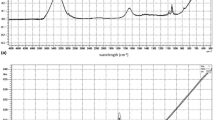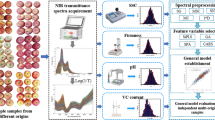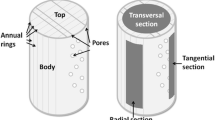Abstract
Spanish wine vinegars belonging to Vinagre de Montilla-Moriles protected designation of origin (PDO) must satisfy some chemical characteristics. These characteristics are mainly responsible of their high and exceptional quality. This study assessed the potential of near-infrared spectroscopy (NIRS) as a non-destructive technology for characterizing wine vinegars belonging to this PDO. A total of 107 vinegars were used to predict major chemical quality parameters (volumic mass, reducing sugars, total acidity and pH) using a scanning monochromator (spectral range 400–2500 nm) with the spinning module, working in transflectance mode. The models developed showed values for the coefficient of regression for cross-validation between 0.95 and 0.99 for volumic mass, reducing sugars and total acidity. Therefore, the results confirm that NIRS technology combined with linear regression strategies such as the modified partial least squares (MPLS) regression can indeed respond to the needs of the vinegar cellars and help them to measure the commonest chemical quality parameters of wine vinegars belonging to Vinagre de Montilla-Moriles (PDO), especially in the case of vinegars with different sugar contents (dry, semi-sweet, sweet and balsamic). However, the number of vinegars as well as their variability should be increased in order to obtain more robust models.

Similar content being viewed by others
References
Anklam E, Lipp M, Radovic B, Chiavaro E, Palla G (1998) Characterisation of Italian vinegar by pyrolysis-mass spectrometry and a sensor device (‘electronic nose’). Food Chem 61:243–248
Bao Y, Liu F, Kong W, Sun DW, He Y, Qiu Z (2014) Measurement of soluble solid contents and pH of white vinegars using VIS/NIR spectroscopy and least squares support vector machine. Food Bioprocess Technol 7:54–61
Barnes RJ, Dhanoa MS, Lister SJ (1989) Standard normal variate transformation and de-trending of near infrared diffuse reflectance spectra. Appl Spectrosc 43:772–777
Boletín Oficial del Estado (BOE) (2012) Real Decreto 661/2012, de 13 de abril, por el que se establece la norma para la elaboración y la comercialización de los vinagres (Spanish regulation 661/2012 of 13 of April for the production and commercialization of vinegars). BOE 100:32031–32036 (in Spanish)
Casale M, Sáiz-Abajo MJ, González-Sáiz JM, Pizarro C, Forina M (2006) Study of the aging and oxidation processes of vinegar samples from different origins during storage by near-infrared spectroscopy. Anal Chim Acta 557:360–366
Corsini L, Castro R, García-Barroso C, Durán-Guerrero E (2019) Characterization by gas chromatography-olfactometry of the most odour-active compounds in Italian balsamic vinegars with geographical indication. Food Chem 272:702–708
Dardenne P (2010) Some considerations about NIR spectroscopy: closing speech at NIR-2009. NIR News 21:8–14
De la Haba MJ, Arias MM, Ramírez P, López MI, Sánchez MT (2014) Characterizing and authenticating Montilla-Moriles PDO vinegars using near infrared reflectance spectroscopy (NIRS) technology. Sensors-Basel 14:3528–3542
Fearn T (2014) The overuse of R2. NIR News 25:32
International Organisation of Vine and Wine (IOV) (2018) Compendium of methods of analysis of wine vinegars. wine vinegars - determination of total acidity content. http://www.oiv.int/en/technical-standards-and-documents/methods-of-analysis/compendium-of-methods-of-analysis-of-wine-vinegars. Accessible 06.06.2019
ISI (2000) The complete software solution using a single screen for routine analysis, robust calibrations and networking. Manual, FOSS NIRSystems/Tecator, Infrasoft International, Silver Spring
López I, Morales J, Ramírez P, Jiménez B (2003) Estudio de la calidad de los vinagres de la provincia de Córdoba (study of the quality of vinegars produced in the province of Cordoba). In: García I (ed) In proceedings of the second symposium on R + D + I for vinegar production. Servicio de Publicaciones de la Universidad de Córdoba, Córdoba, pp 231–238 (in Spanish)
Massart DL, Vandeginste BGM, Deming SM, Michotte Y, Kaufman L (1988) Chemometrics: a textbook. Data handling in science and technology 2. Elsevier Science, Amsterdam
Morales ML, González GA, Casas JA, Troncoso AM (2001) Multivariate analysis of commercial and laboratory produced Sherry wine vinegars: influence of acetification and aging. Eur Food Res Technol 212:676–682
Naes T, Isaksson T, Fearn T, Davies A (2002) A user-friendly guide to multivariate calibration and classification. NIR Publications, Chichester
Nicolaï BM, Beullens K, Bobelyn E, Peirs A, Saeys W, Theron KI, Lammertyn J (2007) Nondestructive measurement of fruit and vegetable quality by means of NIR spectroscopy: a review. Postharvest Biol Technol 46:99–118
Official Diary of The European Communities (ODEC) (1990) Commission Regulation No. 2676/90, of 17 September, determining community methods for the analysis of wines. ODEC No. L272, of 3 October, pp. 1–192
Official Journal of the European Union (OJEU) (2006) Council Regulation (EC) No 510/2006 of 20 March 2006 on the protection of geographical indications and designations of origin for agricultural products and foodstuffs. OJ L 93, 31.3.2006, pp 12–25
Official Journal of the European Union (OJEU) (2015) COMMISSION IMPLEMENTING REGULATION (EU) 2015/48 of 14 January 2015 entering a name in the register of protected designations of origin and protected geographical indications [Vinagre de Montilla-Moriles (PDO)]. OJ L 9, 15.1.2015, pp 11–16
Ozbek N, Akman S (2016) Determination of total sulphur concentrations in different types of vinegars using high resolution flame molecular absorption spectrometry. Food Chem 213:529–533
Paneque P, Morales ML, Burgos P, Ponce L, Callejón RM (2017) Elemental characterisation of Andalusian wine vinegars with protected designation of origin by ICP-OES and chemometric approach. Food Control 75:203–210
Rebelein H (1973) Rapid method for the determination of the alcohol, sugar and total SO2 contents (by distillation) in wine and fruit juices and also for determining blood alcohol. Chem Mikrobiol Technol Lebensm 2:112–121
Ríos-Reina R, García-González DL, Raquel María Callejón RM, Amigo JM (2018) NIR spectroscopy and chemometrics for the typification of Spanish wine vinegars with a protected designation of origin. Food Control 89:108–116
Ríos-Reina R, Callejón RM, Savorani F, Amigo JM, Cocchi M (2019) Data fusion approaches in spectroscopic characterization and classification of PDO wine vinegars. Talanta 198:560–572
Saiz-Abajo MJ, González-Saiz JM, Pizarro C (2004) Classification of wine and alcohol vinegar samples based on near-infrared spectroscopy. Feasibility study on the detection of adulterated vinegar samples. J Agric Food Chem 52:7711–7719
Saiz-Abajo MJ, González-Saiz JM, Pizarro C (2006) Prediction of organic acids and other quality parameters of wine vinegar by near-infrared spectroscopy. A feasibility study. Food Chem 99:615–621
Shenk JS, Westerhaus MO (1991) Population structuring of near infrared spectra and modified partial least squares regression. Crop Sci 31:1548–1555
Shenk JS, Westerhaus MO (1995a) Analysis of agriculture and food products by near infrared reflectance spectroscopy. Monograph. NIRSystem, Inc., Silver Spring
Shenk JS, Westerhaus MO (1995b) Routine operation, calibration, development and network system management manual. NIRSystems, Inc., Silver Spring
Shenk JS, Westerhaus MO (1996) Calibration the ISI way. In: Davies AMC, Williams PC (eds) Near infrared spectroscopy: the future waves. NIR Publications, Chichester, pp 198–202
Shenk JS, Workman J, Westerhaus M (2008) Application of NIR spectroscopy to agricultural products. In: Burns DA, Ciurczac EW (eds) Handbook of near infrared analysis. CRC Press, Taylor & Francis Group, Boca Raton, pp 347–386
Shi JY, Zou XB, Huang XW, Zhao JW, Li Y, Hao L, Zhang J (2013) Rapid detecting total acid content and classifying different types of vinegar based on near infrared spectroscopy and least-squares support vector machine. Food Chem 138:192–199
Suganya S, Park JS, Velmathi S (2014) Visual sensing of aqueous anions by C 2-symmetric chemosensor and its application in real sample analysis. Sensors Actuators B Chem 190:679–684
Tesfaye W, Morales ML, García-Parrilla MC, Troncoso AM (2002) Wine vinegar: technology, authenticity and quality evaluation. Trends Food Sci Technol 13:12–21
Westerhaus MO (1989) Interpretation of regression statistics. In: Marten GC, Shenk JS, Barton FE (eds) Near infrared spectroscopy (NIRS): analysis of forage quality. Agriculture handbook, vol 643. USDA-ARS, US Government Printing Office, Washington, DC, p 39
Williams PC (2001) Implementation of near-infrared technology. In: Williams PC, Norris KH (eds) Near-infrared technology in the agricultural and food industries. AACC Inc, St. Paul, pp 145–169
Windham WR, Mertens DR, Barton FE II (1989) Protocol for NIRS calibration: sample selection and equation development and validation. In: Martens GC, Shenk JS, Barton FE II (eds) Near infrared spectroscopy (NIRS): analysis of forage quality. Agriculture handbook, vol 643. USDA-ARS, US Government Printing Office, Washington, DC, pp 96–103
Xiong C, Su Z, Zhezng Y, Wang Q, Ling Y, Liu Z, Li Y, Zhang J, Yang G, Zhang X (2017) Characterization of the thermal degradation of vinegar and the construction of an identification model for Chinese geographical indication vinegars by the Py-GC-MS technique. J AOAC Int 100:503–509
Yin Y, Hao Y, Bai Y, Yu H (2017) A Gaussian-based kernel fisher discriminant analysis for electronic nose data and applications in spirit and vinegar classification. J Food Meas Charact 11:24–32
Acknowledgements
The authors would like to thank the Central Research Support Service of the University of Córdoba and especially Dr. Juan García Olmo, as well as the Vinagre de Montilla-Moriles (PDO) vinegar cellars.
Author information
Authors and Affiliations
Corresponding authors
Ethics declarations
Conflict of Interest
María-Teresa Sánchez declares that she has no conflict of interest. Rocío Márquez declares that she has no conflict of interest. Irina Torres declares that she has no conflict of interest. María-José de la Haba declares that she has no conflict of interest. Dolores Pérez-Marín declares that she has no conflict of interest. María-Isabel López declares that she has no conflict of interest.
Ethical Approval
This article does not contain any studies with human participants or animals performed by any of the authors.
Informed Consent
Informed consent was obtained from all individual participants included in this study.
Additional information
Publisher’s Note
Springer Nature remains neutral with regard to jurisdictional claims in published maps and institutional affiliations.
Rights and permissions
About this article
Cite this article
Sánchez, MT., Márquez, R., Torres, I. et al. Chemical Characterization of Wine Vinegars Belonging to the Vinagre de Montilla-Moriles Protected Designation of Origin, Using Near-Infrared Spectroscopy. Food Anal. Methods 13, 802–810 (2020). https://doi.org/10.1007/s12161-019-01697-z
Received:
Accepted:
Published:
Issue Date:
DOI: https://doi.org/10.1007/s12161-019-01697-z




